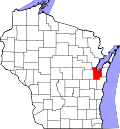2010 census
As of the census [3] of 2010, there were 17,399 people, 6,941 households, and 4,763 families living in the village. The population density was 961.3 inhabitants per square mile (371.2/km2). There were 7,223 housing units at an average density of 399.1 per square mile (154.1/km2). The racial makeup of the village was 93.8% White, 1.5% Black, 1.2% Native American, 1.3% Asian, 0.6% from other races, and 1.6% from two or more races. Hispanic or Latino of any race were 2.4% of the population.
There were 6,941 households, of which 37.0% had children under the age of 18 living with them, 52.9% were married couples living together, 10.9% had a female householder with no husband present, 4.8% had a male householder with no wife present, and 31.4% were non-families. 24.0% of all households were made up of individuals, and 8.2% had someone living alone who was 65 years of age or older. The average household size was 2.50 and the average family size was 2.98.
The median age in the village was 36.3 years. 26.7% of residents were under the age of 18; 7.9% were between the ages of 18 and 24; 28.5% were from 25 to 44; 26.1% were from 45 to 64; and 10.7% were 65 years of age or older. The gender makeup of the village was 48.3% male and 51.7% female.
2000 census
As of the census [4] of 2000, there were 13,546 people, 5,236 households, and 3,691 families living in the village. The population density was 753.7 people per square mile (291.0/km2). There were 5,350 housing units at an average density of 297.7 per square mile (114.9/km2). The racial makeup of the village was 96.16% White, 0.73% African American, 0.90% Native American, 0.78% Asian, 0.01% Pacific Islander, 0.32% from other races, and 1.10% from two or more races. Hispanic or Latino of any race were 1.09% of the population.
There were 5,236 households, out of which 38.2% had children under the age of 18 living with them, 57.7% were married couples living together, 9.3% had a female householder with no husband present, and 29.5% were non-families. 21.7% of all households were made up of individuals, and 6.0% had someone living alone who was 65 years of age or older. The average household size was 2.57 and the average family size was 3.04.
In the village, the population was spread out, with 27.8% under the age of 18, 8.6% from 18 to 24, 34.8% from 25 to 44, 21.3% from 45 to 64, and 7.5% who were 65 years of age or older. The median age was 34 years. For every 100 females, there were 96.6 males. For every 100 females age 18 and over, there were 94.7 males.
The median income for a household in the village was $51,974, and the median income for a family was $56,579. Males had a median income of $40,081 versus $25,900 for females. The per capita income for the village was $21,688. About 3.2% of families and 4.3% of the population were below the poverty line, including 4.7% of those under age 18 and 3.7% of those age 65 or over.










